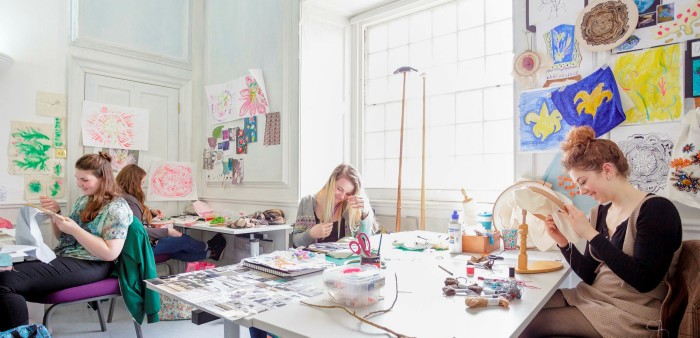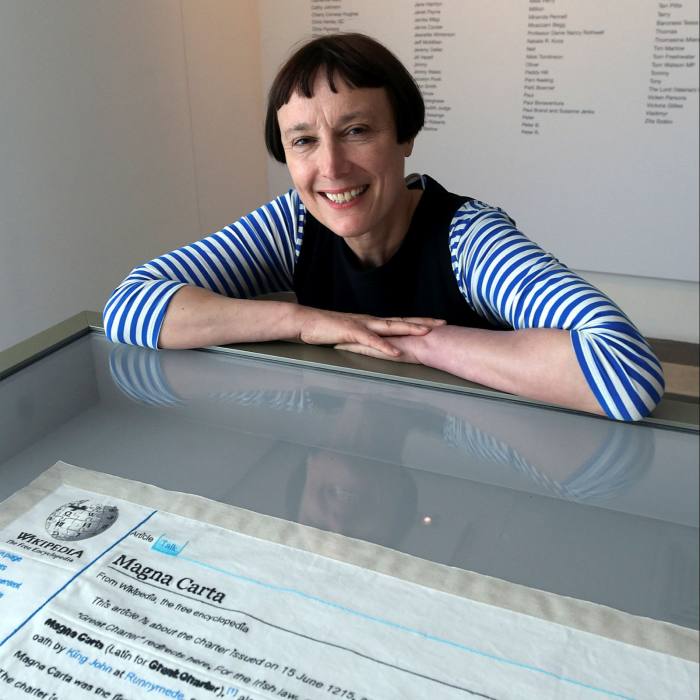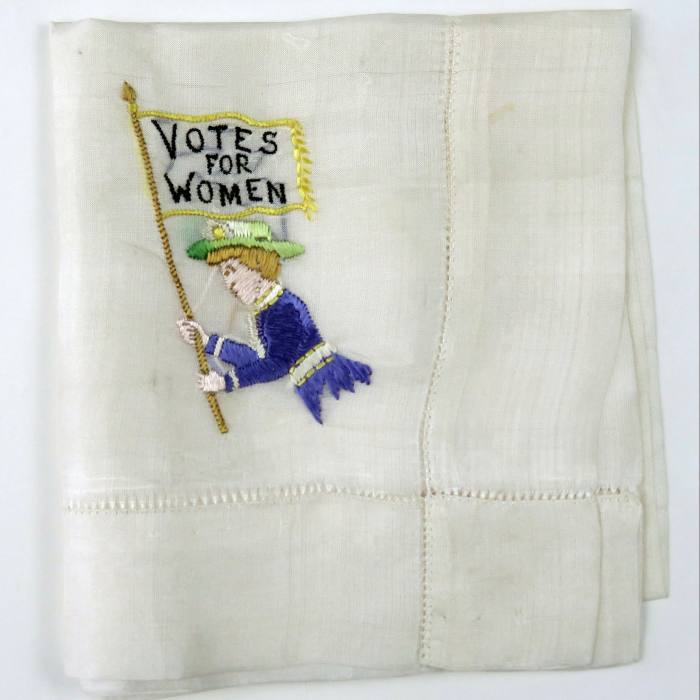[ad_1]
When the Royal School of Needlework opened its 1st studio previously mentioned a bonnet store in London’s Sloane Street in 1872, it had two aims. The initially was to present perform for gentlewomen of straitened signifies at a time when employment alternatives have been scarce. The 2nd was to preserve and endorse the artwork of embroidery — usually portrayed as demure and conventional — as a dynamic, expressive medium.
A new exhibition, 150 Years of the Royal College of Needlework: Crown to
Catwalk, at London’s Trend and Textile Museum until eventually September 4, provides its historical past to daily life in colourful element. Much more than 120 pieces — including gleaming coronation robes, collaborations with trend designers E Tautz and Sarah Burton, avant-garde styles in upcycled products, ecclesiastical trappings and Arts and Crafts upholstery — convey the ability and diversity of the school’s output. It is all proof that needlework is anything but old-fashioned.
I get a feeling of this on my tour of the college, set in the panelled “grace and favour” residences of Hampton Courtroom. The school’s BA degree in hand embroidery is special in Europe (graduates have labored in film and for vogue properties this kind of as Alexander McQueen). The shorter certificate and diploma is also taught at the school’s outposts in Japan and the US. Its instructor-instruction Long term Tutors Programme lasts three a long time. On-line courses, established up to satisfy desire through the pandemic, are flourishing. There are now 1,000 pupils: from university leavers to retirees attaining ambitions of late-existence creativeness.
An environment of cheerful concentration pervades. 1 team is finding out 17th-century Jacobean crewelwork — flowing foliage and fauna motifs labored in wool on linen — a record of stitches by their side. A couple doorways away, the BA college students are coming up with gloves impressed by portraits. In the studio, tables are shrouded in dust sheets to conserve functions in development and I am politely requested not to get shots. This is in which fragile historic textiles are restored and commissions — for artists and designers — developed. A new piece, teeming with wild flowers, seems to be like a painting.
Inspecting the back of a fine, 19th-century piece labored in silk, I inquire: “Where are the knots?” Anyone laughs. At the RSN, knots are applied to secure the stitches, but never found.


The school’s earliest ingestion was impoverished middle-class women, typically from people where the father experienced died younger, leaving them with no breadwinner. Learners paid out for nine times of classes, suggests chief govt Susan Kay-Williams from her attic workplace, which looks out on to royal topiary. “After three days, if they confirmed no aptitude, they were being despatched property with a refund.” Thriving candidates moved to the workroom. Pace was all as staff have been paid out by the item, as a result the phrase “piecework”.
It was not till 1900 that salaries — “enough to retain entire body and soul together” — had been launched, states Kay-Williams, creator of An Unbroken Thread: Celebrating 150 A long time of The Royal University of Needlework.
The school operated on a non-gain basic principle, she claims. “We were being established as what would be termed a social business these days.” The RSN became a registered charity in 1964, and gets no authorities funding. The attached workroom is now named the Studio.
“If we deliver in extra income than we invest, it goes to underpin upcoming developments. The profits obtained is also utilized to guidance bursaries for pupils on the Potential Tutor and degree programmes,” says Kay-Williams.
The RSN’s other founding goal was, as its very first president, Princess Helena, daughter of Queen Victoria, wrote, “to restore the virtually lost art of ornamental needlework to its higher area among ornamental arts”. In the 1800s elaborate embroideries — for dresses or interiors — ended up eclipsed by the simpler Berlin Wool Perform style. The RSN set out to reverse the trend.
Very good style was essential. To retain requirements an art committee, led by artists Sir Frederic Leighton and Val Prinsep, was recognized. Early types by Arts and Crafts luminaries William Morris, Walter Crane and Edward Burne-Jones designed their debut at the Philadelphia Centennial International Exhibition in 1876. Swingeing import tariffs of 35 for every cent intended that the undertaking was a industrial flop. But it did provide art embroidery to the US. Candace Wheeler, the Martha Stewart of her working day, was motivated to establish New York’s answer to the RSN: the Society of Ornamental Artwork.

To offer workers with steady employment, departments for church function and armed service regalia had been opened. Royal commissions are one more of the show’s draws. The Queen Mother’s 1937 gown of estate, embellished with Commonwealth flora, and Edward VII’s cloth of gold coronation cope the two function. For her coronation in 1953, the Queen’s robe of condition gleamed with tiny olives and sheaves of wheat — symbols of a new Elizabethan period of prosperity — hand-stitched in gold thread.
Greater works are almost never signed. “One of our unique mantras was that no make any difference how many folks perform on a piece — it will generally look like the work of a single particular person. The other just one is ‘never a seat shall go cold’, due to the fact as before long as one human being receives up, a further will get their area. It’s teamwork,” suggests Kay-Williams.
Royalty also manufactured an look at the RSN’s yearly product sales. Held at grand residences with a butler hovering in attendance, they had been a staple of the London social “season” till the second planet war. Family paraphernalia — scorching water bottle covers, mattress linen — stuffed the stands.
Lingerie is just one of the show’s additional stunning reveals, but the university has always experienced to generate its maintain. In the 1910s and 1920s, brides-to-be could stock their trousseaux with negligees or dressing gowns in modern tones of eau-de-nil or apricot. Tatler’s diarist, viewing a sale, gushed in 1916: “Awful good sensation it offers you combining, properly, pink crepe de chine with charity.”
Perceptions of embroidery — and its uses — have improved in excess of the many years, claims Kay-Williams. In draughty Tudor or Jacobean residences, wool-worked hangings and bed covers provided insulation. For the Elizabethans, a finely worked cuff signified wealth. In the late 19th century, blossom-strewn screens brought the modish Japonisme model to interiors.
Then there is the gender query. Sewing is typically portrayed as female. Historically that is not the case. “In the 1930s all the royal household stitched, together with the King and the Dukes of York and Gloucester. Needlework was also a way to go the several hours for naval officers or troopers posted abroad,” states Kay-Williams.
Sometimes things get political. The suffragettes embroidered handkerchiefs with slogans and protesters at Greenham Common in the 1980s stitched banners, she suggests. To mark the 800th anniversary of the Magna Carta in 2015, the artist Cornelia Parker made use of needlework for her big edition of it. Labored on by a workforce of prisoners, craftspeople and superstar volunteers, the 13-metre-very long piece was a copy of the medieval document’s Wikipedia site. The RSN’s contribution to the “Great Constitution of Freedoms” was, unsurprisingly, the gold crown.


Pekinese, Van Dyke, bullion, French knot: RSN pupils discover stitches that day back again to antiquity. The school’s handbook, printed in 1880, is continue to referred to. Specifications are scrupulous, but this is not slavish discovering by rote. “We want pupils to improvise, decide on their own stitches and colours,” says Kay-Williams. Traditional elements are silk, wool or metallic thread straw, feathers or upcycled fish netting are welcome way too. For designer E Tautz, pupils appliqued scraps of denim and cotton salvaged from recycling banking institutions.
“That’s what can make us various,” suggests Kay-Williams. “We educate classic hand skills but we challenge college students to go in dynamic instructions.”
She demonstrates me a portrait. What seems like pen and ink is in fact blackwork, an Elizabethan stitch tailored for pictorial result. The sitter is Norman Willis, former Trades Union Congress chief and RSN Trustee. All through fraught union negotiations, Willis would also dig out his needle and thread “for that calming moment”, she states.
The RSN was an early advocate of needlework for mindfulness, a different of the show’s themes. All through the 1st planet war, it available free sewing lessons to troopers and established layouts for returning servicemen as occupational remedy (the altar covering at St Paul’s Cathedral was labored on by hurt servicemen). In the next world war, sewing kits for regimental badges ended up dispatched to prisoners of war.

Lockdown also prompted lots of people today to rummage in their stitching containers. “People realised how practical it was for releasing stress,” states Kay-Williams. Website visitors to the clearly show will have a prospect to sample its therapeutic features for on their own.
Remote understanding classes and international summertime faculty periods work in three diverse time zones like “an invisible thread”, claims Kay-Williams, binding stitchers throughout the world.
Boosting cash to cover the costs of resources, salaries and bursaries has constantly been “painful”, she adds. Support will come from Metropolis of London livery firms, legacies, foundations and pals.
Resourcefulness and agility have ensured the charity’s survival. Its newest undertaking is the RSN Sew Bank, a digital resource established up in 2021 to conserve endangered procedures. Cost-free to access, there are 225 procedures (supporters can also “adopt a stitch”), accompanied by how-to videos. It has proved a hit with the school’s new, global next of stitchers who are trying to keep needlework alive and appropriate: just as its 19th-century founders meant.
Uncover out about our most up-to-date stories initial — comply with @FTProperty on Twitter or @ft_houseandhome on Instagram
[ad_2]
Source website link





More Stories
GPS Vehicle Tracking – Five Top ROI Benefits
Electric Car Conversion Kit – Turn Your Gasoline Powered Vehicle Into an Electric Transporter
3.5T or 7.5T Recovery Vehicle